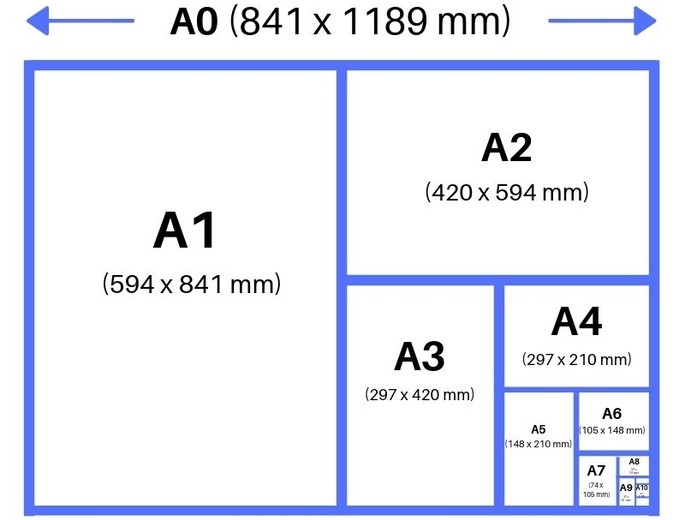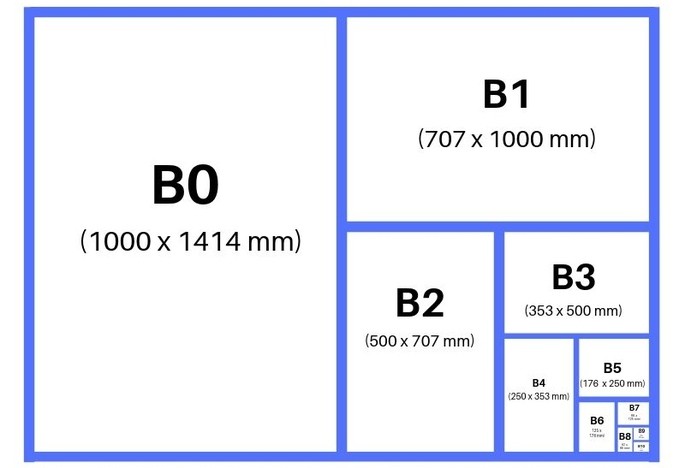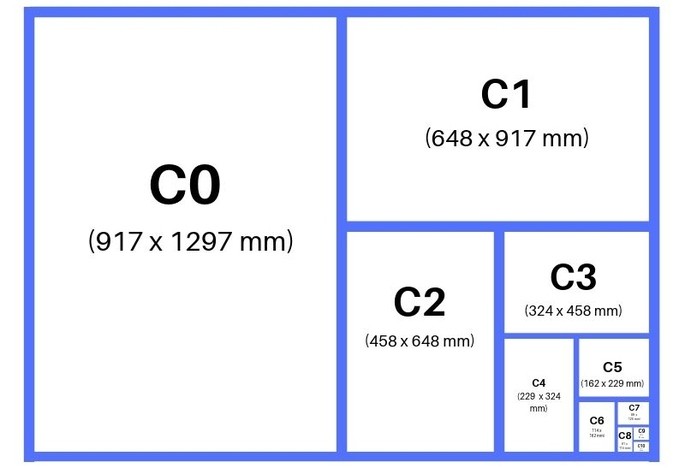There are two major classifications of paper sizes:
- European format: ISO 216 series A, B and C.
- American format: letter, legal and tabloid size.
The European format is the most widely used almost everywhere in the world, and while the American format is mostly popular in some countries of the American continent.
The standardization of paper dimensions helps to unify production and printing criteria. At the same time, it serves as a guide for professionals in related industries, such as publishing, advertising, or office supplies.
Paper size series A

The most widely used paper size in almost every country in the world is the A series, known as the fundamental series, because other sizes are derived from it. These are the sheet sizes:
| Paper size | Millimeters | Centimeters | Inches | |
|---|---|---|---|---|
| A Series | A0 | 841 x 1189 mm | 4.1 x 118.9 cm | 46.8 in. |
| A1 | 594 x 841 mm | 59.4 x 84.1 cm | 23.4 x 33.1 in. | |
| A2 | 420 x 594 mm | 42 x 59.4 cm | 16, 5 x 23.4 inches | |
| A3 | 297 x 420 mm | 29.7 x 42 cm | 1.7 x 16.5 in. | |
| A4 | 210 x 297 mm | 21 x 29.7 cm | 8.3 x 11.7 in. | |
| A5 | 148 x 210 mm | 14.8 x 21 cm | 5.8 x 8.3 inches | |
| A6 | 105 x 148 mm | 10.5 x 14.8 cm | 4.1 x 5.8 in. | |
| A7 | 74 x 105 mm | 7.4 x 10.5 cm | 2.9 x 4.1 in. | |
| A8 | 52 x 74 mm | 5.2 x 7.4 cm | 2 x 2.9 in. | |
| A9 | 37 x 52 mm | 3.7 x 5.2 cm | 1.5 x 2 inches | |
| A10 | 26 x 37 mm | 2.6 x 3.7 cm | 1 x 1.5 in. | |
See also paper sizes A0, A1, A2, A3, A3, A4, A5, A6, A6, A7, A8, A9, A10.
B-series paper size

The B series is made up of page formats that are usually used to make posters and books. These are their measurements:
| Paper size | Millimeters | Centimeters | Inches | |
|---|---|---|---|---|
| B Series | B0 | 1000 x 1414 mm | 100 x 141.4 cm | 39.4 x 55.7 in. |
|
B1 |
707 x 1000 mm | 70.7 x 100 cm | 27.8 x 39.4 in. | |
| B2 | 500 x 707 mm | 50 x 70.7 cm | 19.7 x 27.8 in. | |
| B3 | 353 x 500 mm | 35, 3 x 50 cm | 13, 9 x 19.7 in. | |
| B4 | 250 x 353 mm | 25 x 35.3 cm | 9.8 x 13.9 in. | |
| B5 | 176 x 250 mm | 17.6 x 25 cm | 6.9 x 9.8 inches | |
| B6 | 125 x 176 mm | 12.5 x 17.6 cm | 4.9 x 6.9 in. | |
| B7 | 88 x 125 mm | 8.8 x 12.5 cm | 3.5 x 4.9 in. | |
| B8 | 62 x 88 mm | 6.2 x 8.8 cm | 2.4 x 3.5 in. | |
| B9 | 44 x 62 mm | 4.4 x 6.2 cm | 1.7 x 2.4 in. | |
| B10 | 31 x 44 mm | 3.1 x 4.4 cm | 1.2 x 1.7 in. | |
C series paper size

The C series paper formats are used to create envelopes. These are their measurements:
| Paper size | Millimeters | Centimeters | Inches | |
|---|---|---|---|---|
| C Series | C0 | 917 x 1297 mm | 91.7 x 129.7 cm | 36.1 x 51.5 in. |
| C1 | 648 x 917 mm | 64.8 x 91.7 cm | 25.5 x 36.1 in. | |
| C2 | 458 x 648 mm | 45.8 x 64.8 cm | 18.0 x 25.5 inches | |
| C3 | 324 x 458 mm | 32.4 x 45.8 cm | 12.8 x 18.0 in. | |
| C4 | 229 x 324 mm | 22.9 x 32.4 cm | 9.0 x 12.8 in. | |
| C5 | 162 x 229 mm | 16.2 x 22.9 cm | 6.4 x 9.0 in. | |
| C6 | 114 x 162 mm | 11.4 x 16.2 cm | 4.5 x 6.4 in. | |
| C7 | 81 x 114 mm | 8 x 11.4 cm | 3.2 x 4.5 in. | |
| C8 | 57 x 81 mm | 5.7 x 8.1 cm | 2.2 x 3.2 in. | |
| C9 | 40 x 57 mm | 4 x 5.7 cm | 1.6 x 2.2 in. | |
| C10 | 28 x 40 mm | 2.8 x 4 cm | 1.1 x 1.6 inches | |
Letter, legal and tabloid size
In the United States, Canada and some Latin American countries, paper formats other than A-series are used. They are called letter, legal, letter and legal, included within the traditional American measurement system.

These page sizes are used especially for letter and document drafting purposes. These are their dimensions:
| Paper size | Millimeters | Centimeters | Inches | |
|---|---|---|---|---|
| American system | Charter | 220 x 280 mm | 22 x 28 cm | 8.6 x 11 inches |
| Oficio | 220 x 340 mm | 22 x 34 cm | 8.6 x 13.3 inches | |
| Letter | 216 x 279 mm | 21,6 x 27, 9 cm | 8.5 x 10, 9 in. | |
| Legal | 216 x 356 mm | 21, 6 x 35, 6 cm | 8, 5 x 14 inches | |
| Tabloid | 279.4 x 431.8 mm (279.4 x 431.8 mm) | 27.9 x 43.1 cm | 11 x 17 inches | |
Like letter sizes and letter have similar sizes, it is common for them to be used interchangeably. The same is true for legal and legal size, hence, although it is not an explicit rule, the Anglo-Saxon system formats are usually reduced to letter and legal size for practical purposes.
On the other hand, tabloid size is the size used in the production of many newspapers printed in the Americas.
Paper dimensions according to ISO 216
There is a notable difference between the A series sizes, which are the most widely used in the world, and the sheet sizes used in much of the Americas. The reason for this difference is the DIN 476 standard, created in Germany by engineer Walter Porstmann in 1917.
The objective of this first standardization was to use as much paper as possible. As the measures proved to be efficient, they were maintained over time. Hence, when the International Organization for Standardization (ISO) decided to establish the dimensions of the different paper formats, they simply adhered to the measurements established in DIN 476, considered the pioneer standard.
Currently, ISO 216 is used almost everywhere in the world, with the exception of Canada, the United States, most Central American countries, Venezuela, Colombia and Chile, where letter and legal size is used, letter, legal and tabloid of the American system instead of their A-series equivalents.
See also:




